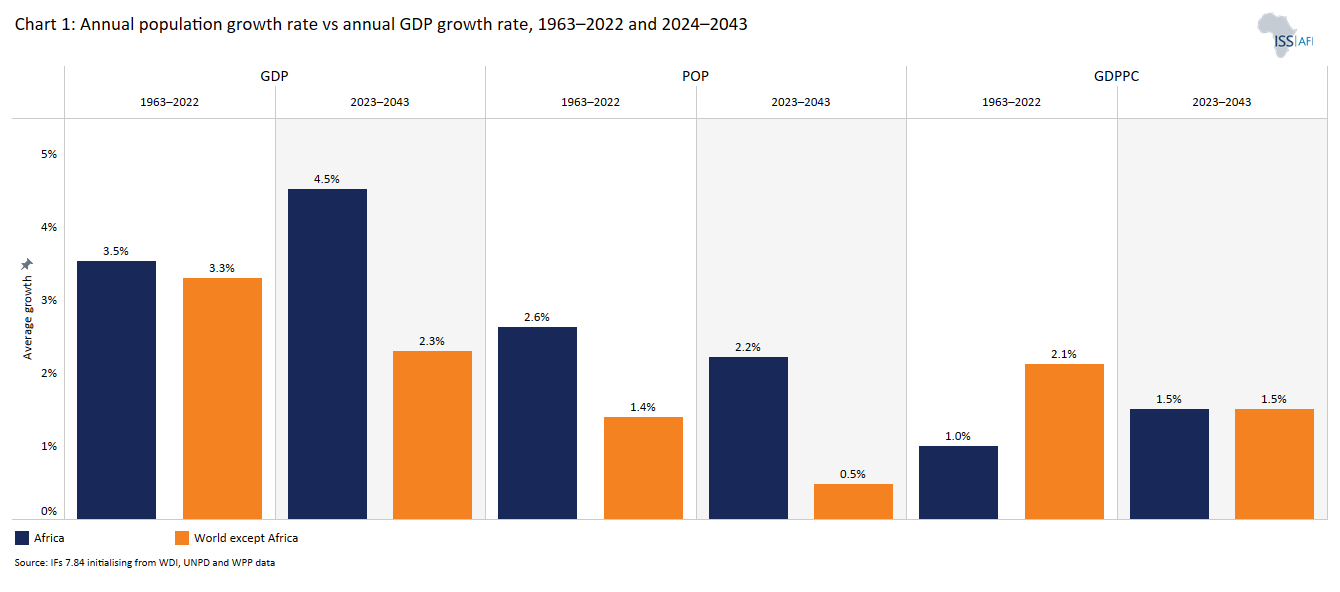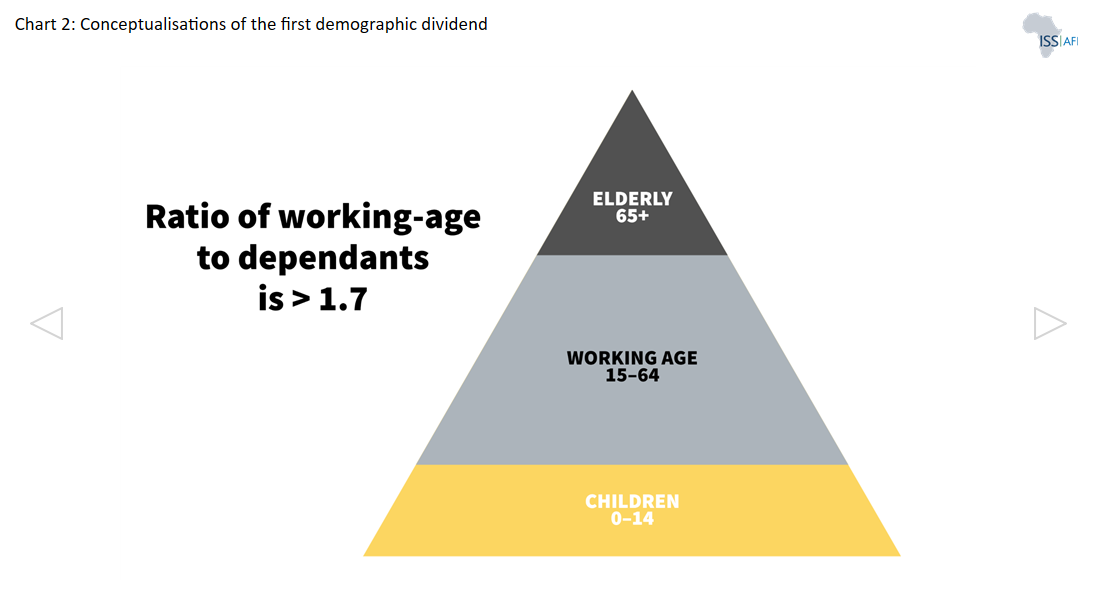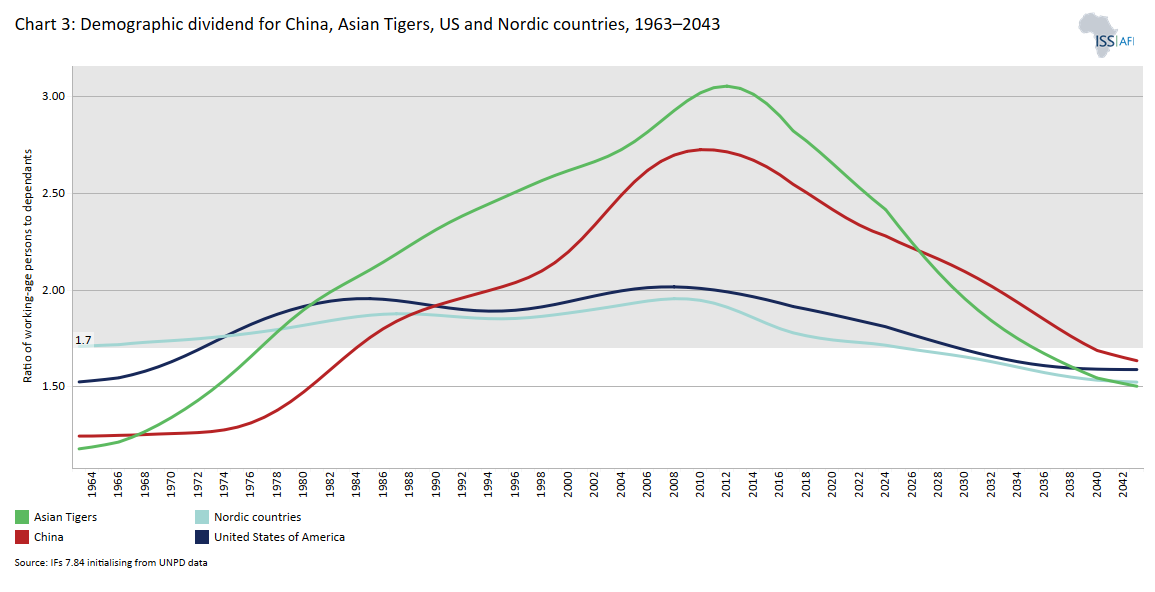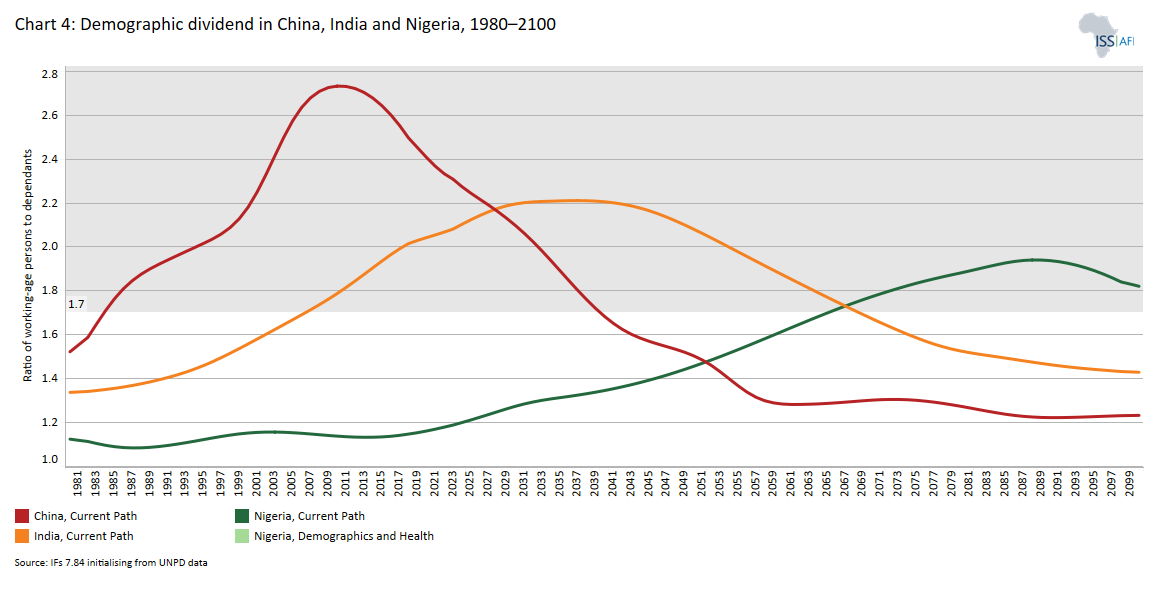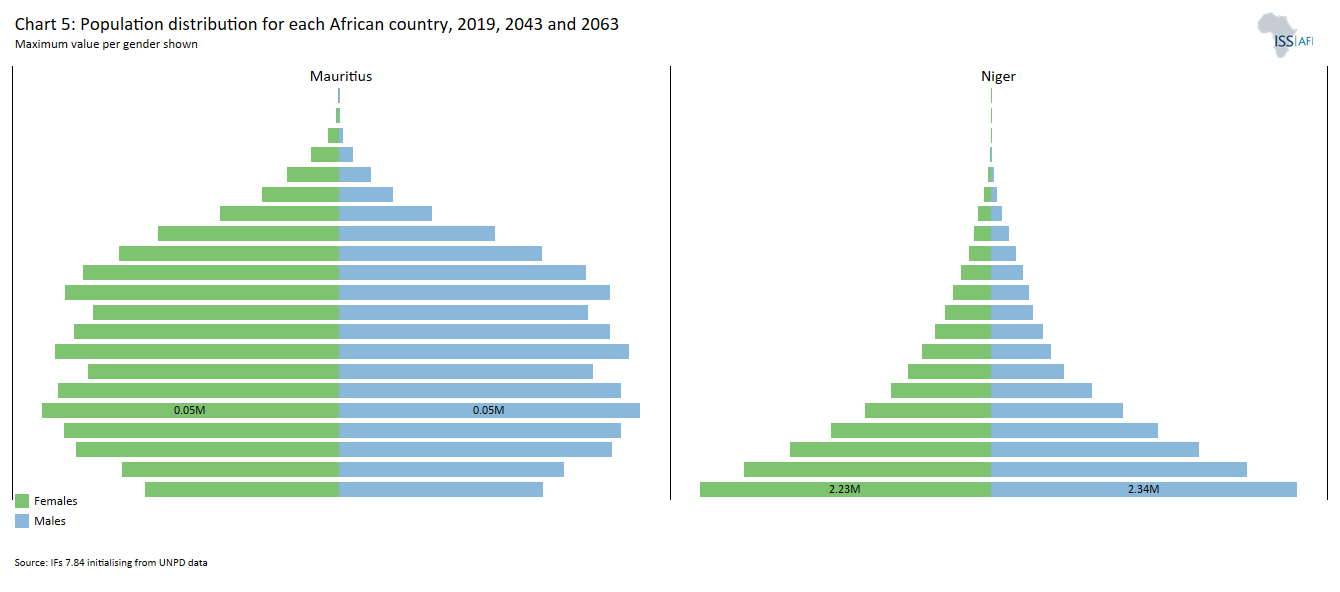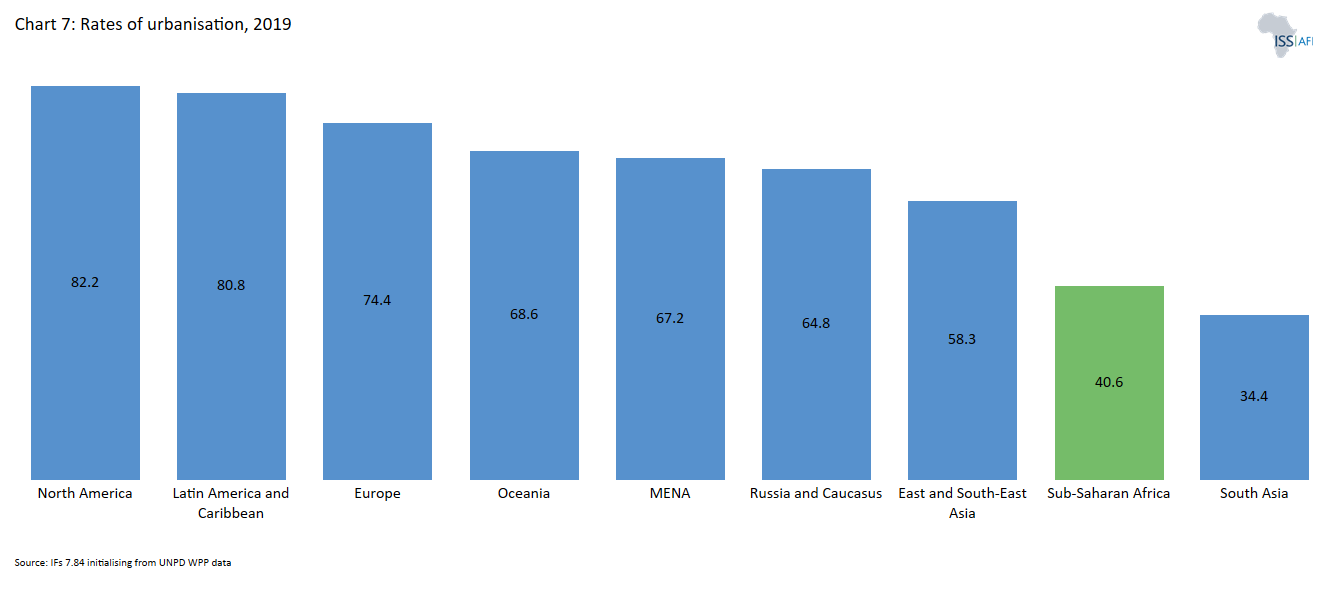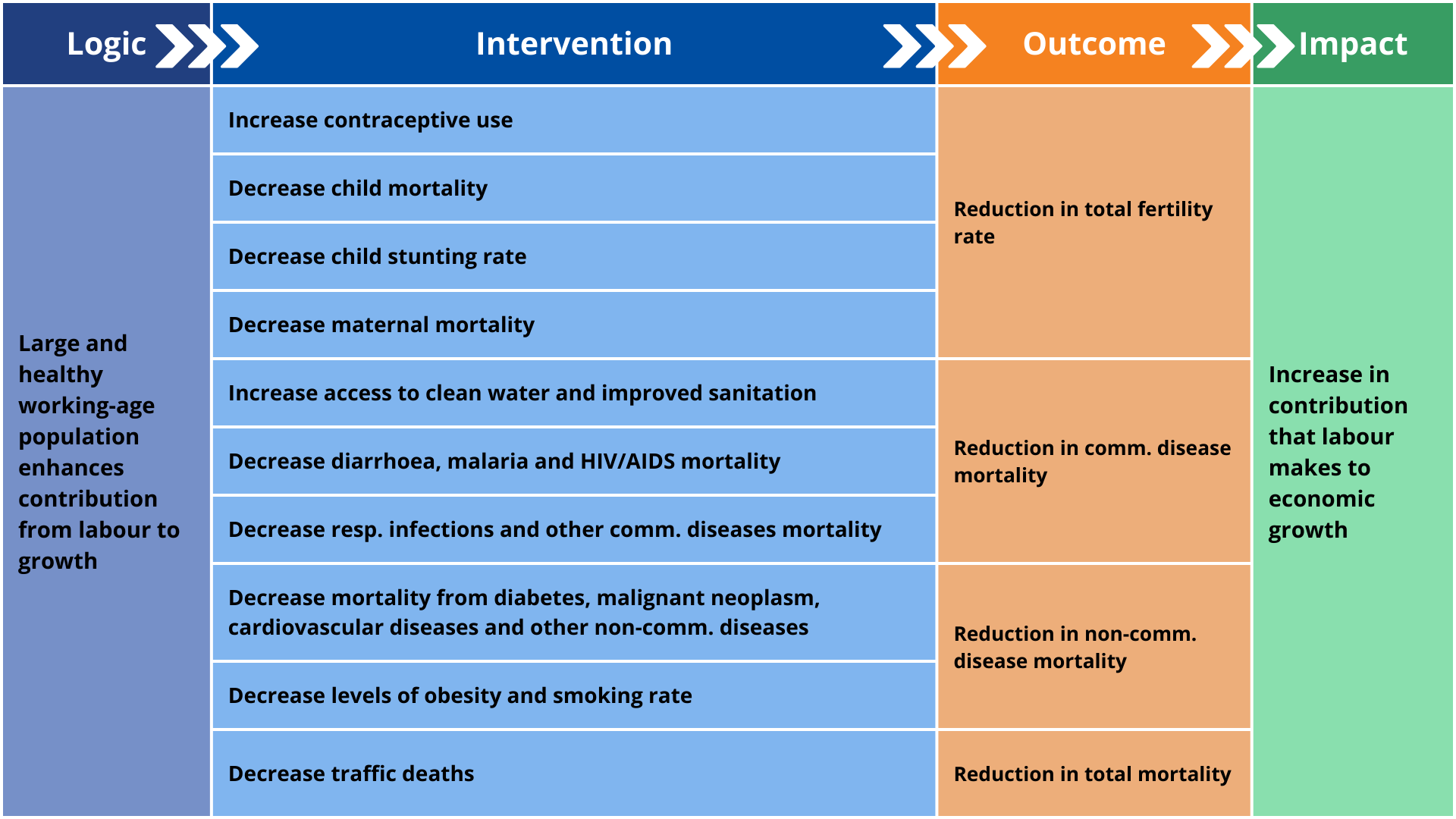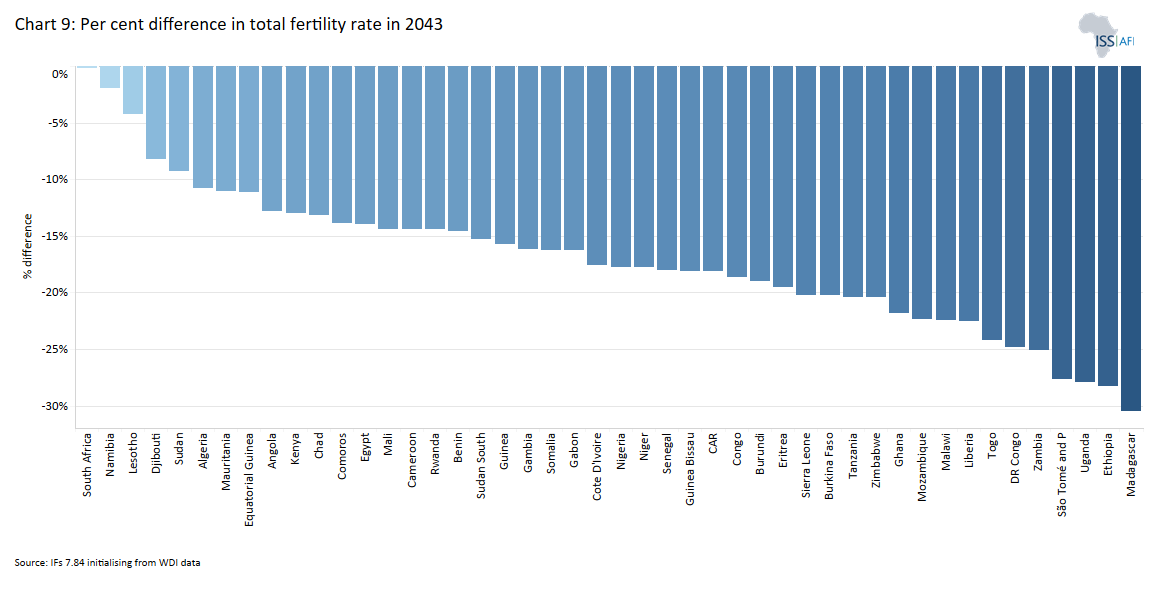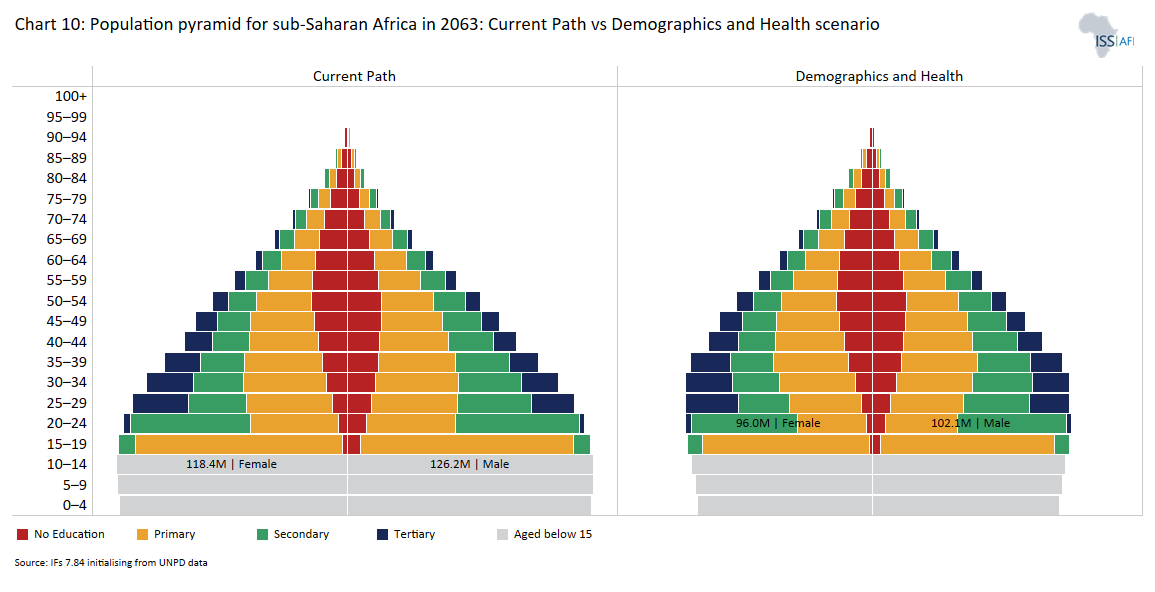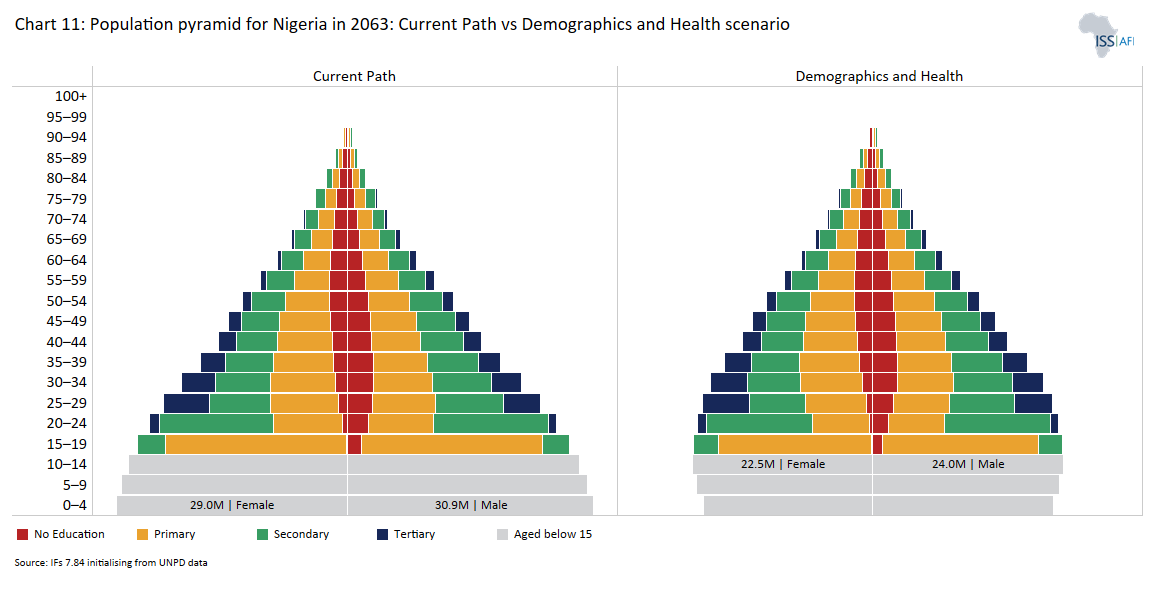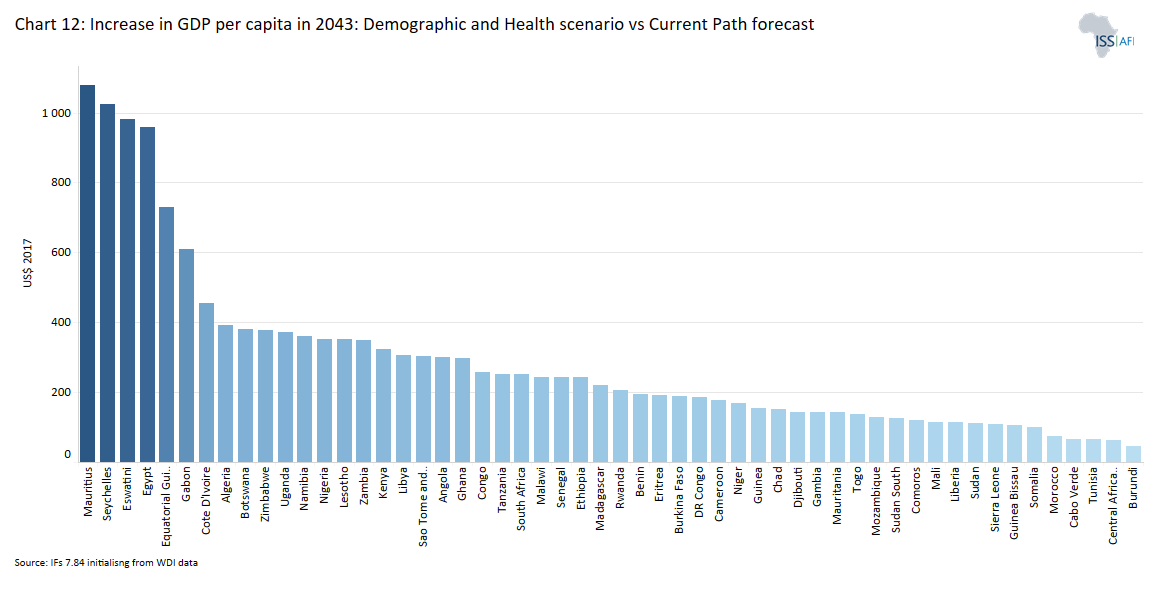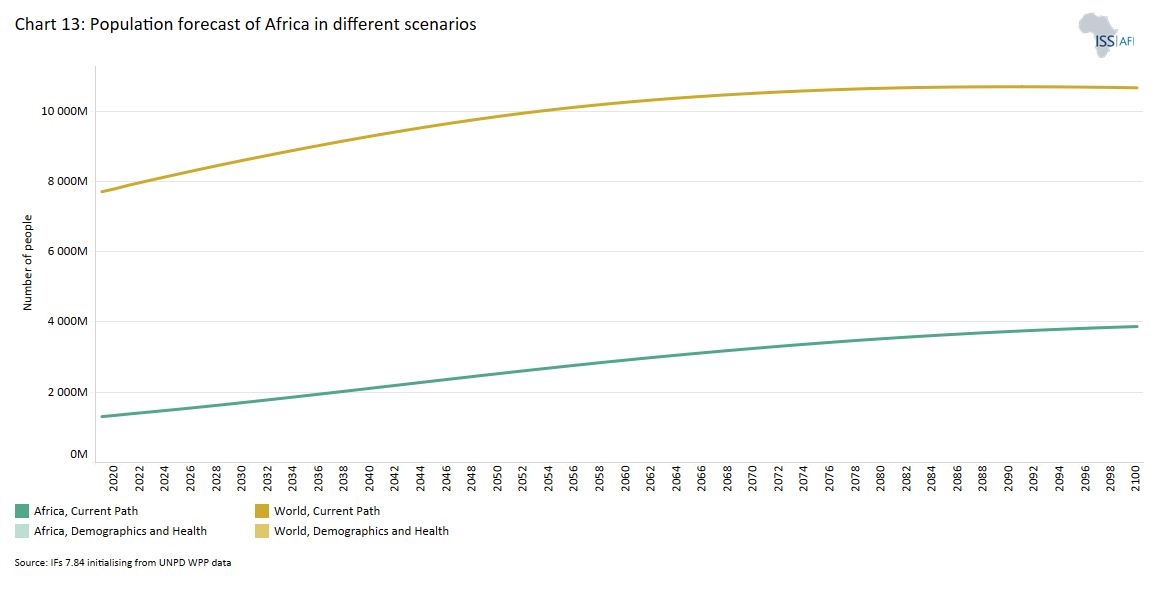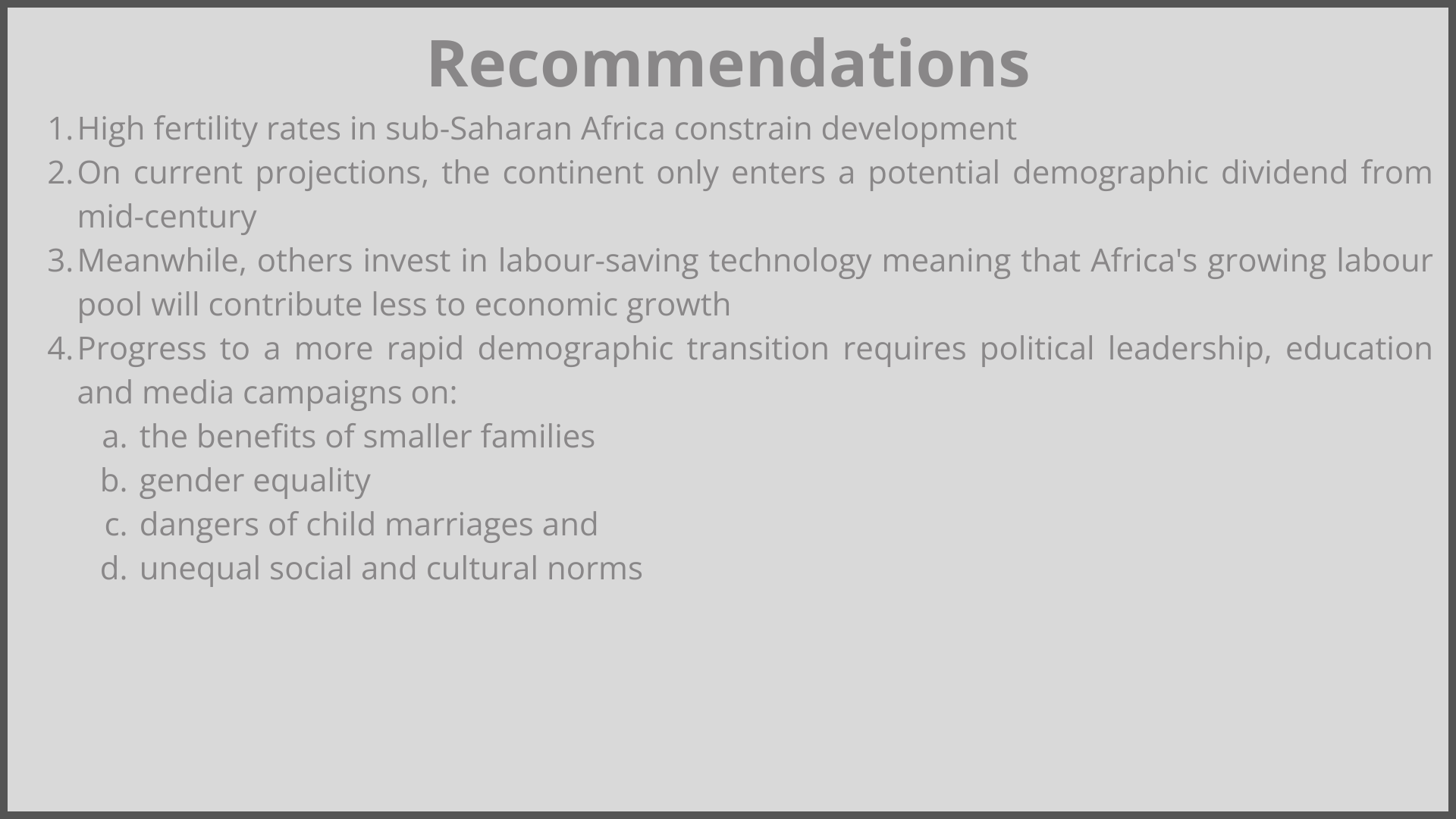 3 Demographics
3 Demographics
Feedback welcome
Our aim is to use the best data to inform our analysis. See our Technical page for information on the IFs forecasting platform. We appreciate your help and references for improvements via our feedback form.
This theme describes how Africa’s slow demographic transition constrains its development outcomes given the low ratio of its working-age population to dependants. It then discusses the structure of a Demographics and Health scenario and its potential impact on key development outcomes. The analysis highlights the significance of family planning, female empowerment and education, thereby fostering a more productive labour force. Additionally, it explores the broader social and political benefits of demographic shifts, such as reduced political turbulence and increased likelihood of liberal democracy, offering a comprehensive view of how progressive demographics can unlock Africa's growth potential.
Please see About this Site for more information about the International Futures modelling platform we use for our scenarios.
Summary
We begin this page with an overview of demographics. The introduction explains the concept of the demographic dividend and its significance for economic growth, particularly highlighting how a shift in population structure can impact development outcomes.
- The demographic dividend can be presented in several ways, ranging from the ratio of working-age persons to dependants, to fertility rates and median age.
Next, we analyse current demographic trends and projections. We discuss the current population structure in Africa, including fertility rates, mortality rates and the ratio of working-age individuals to dependants. This section also assesses urbanisation and provides future projections, outlining when Africa might enter a potential demographic window of opportunity and the impacts of more rapid progress.
- Because of high fertility rates, Africa is several decades away from experiencing a first demographic dividend, the point at which more working-age persons relative to dependants contribute to more rapid economic growth.
- A positive demographic dividend explains a large part of the economic growth rates and high-income status of the US and much of Europe, and the rapid growth rates of the Asian Tigers and China. Although the ratio of sub-Saharan Africa’s working-age population to dependants is growing, it is late and slow.
- Africa is experiencing a slow demographic transition driven to a large extent by its low levels of urbanisation.
- Lower fertility rates are generally associated with improved human capital such as better education and health.
Moving beyond the Current Path, we examine the impact of the Demographics and Health scenario. This part explores a scenario where improved health outcomes and demographic changes could accelerate Africa’s developmental progress.
- The Demographics and Health scenario shows that rapid uptake of contraceptive use and lower child and maternal mortality rates can have a large impact on fertility.
- The scenario also improves incomes and reduces poverty.
- A reduction in the growth rate of the African population will impact on the size of the global population with important benefits such as reduced carbon emissions.
- Sub-Saharan Africa needs to reduce its high population dependency structure to benefit from the associated economic, social and political effects.
- The impact of the Demographics and Health scenario is discussed separately in the Demographics and the Health themes, and its impact on African countries and regions is presented in each geographic report elsewhere on this website.
In a concluding section, we discuss broader social and political implications of a changing demographic structure, such as reduced political turbulence and implications for the education system.
All charts for Demographics
- Chart 1: Annual population growth rate vs annual GDP growth rate
- Chart 2: Conceptualisations of the first demographic dividend
- Chart 3: Demographic dividend for China, Asian Tigers, US and Nordic countries, 1963–2043
- Chart 4: Demographic dividend in China, India and Nigeria, 1980–2100
- Chart 5: Population distributions for each African country, 2019, 2043 and 2063
- Chart 6: Demographic dividend in Africa and the world except Africa, 1963–2100
- Chart 7: Rates of urbanisation, 2019
- Chart 8: Demographics and Health scenario
- Chart 9: Per cent difference in total fertility rate in 2043
- Chart 10: Population pyramid for sub-Saharan Africa in 2063: Current Path vs Demographics and Health scenario
- Chart 11: Population pyramid for Nigeria in 2063: Current Path vs Demographics and Health scenario
- Chart 12: Increase in GDP per capita in 2043: Demographic and Health scenario vs Current Path forecast
- Chart 13: Population forecast of Africa in different scenarios
- Chart 14: Key recommendations
Population growth and age structure are critical determinants of economic growth. A larger population translates into a larger economy, but not necessarily higher incomes, less poverty or better living conditions. Given the importance of labour to fuel growth (as opposed to capital and technology), in low- and middle-income economies, the size of the labour force must increase more rapidly than the total population and steadily improve productivity, implying changes to fertility, more and better education and health, among other considerations.
The average annual rate at which the African economy expanded from 1963 to 2022 is 3.5% (see Chart 1). Because Africa has a young and rapidly expanding population, the 3.5% translated into less than 1% average improvement in gross domestic product (GDP) per capita. Meanwhile average economic growth rates in the rest of the world over the same period was slighly lower, at 3.3%, but because populations there expanded more slowly, GDP per capita grew more than twice as rapidly.
The Current Path forecast is for the African economy to expand by a healthy 4.5% from 2023 to 2043 compared to 2.3% average for the rest of the world. Because of rapid population growth 4.5% will translate into GDP per capita growth of only about 1.5% per annum in Africa and about the same in the rest of the world. However, for Africa to close the gap in GDP per capita with the average for the rest of the world by 2043, growth rates in Africa would need to average almost 15% from 2023 to 2043. The main reason for the large difference is that while Africa's population will expand by 2.2% annually, in the rest of the world population growth will be only 0.5%.
This website models several scenarios including the impact of more and better education, a manufacturing transition and a revolution in agriculture to unlock Africa's growth potential. A more rapid demographic transition to lower fertility rates will play an important facilitating role across all sectors.
In 2019 Africa's total population was estimated at 1.3 billion with average total fertility rate (TFR) of 4.4 births per fertile woman, more than double the average for the rest of the world. By 2043, Africa’s total population will have increased to 2.2 billion and fertility will decline to 3.2 births, and it is on course to reach 3 billion by 2063 at which point TFR will be at just below 2.3 births. There is some dispute as to exactly how rapidly fertility rates in Africa are declining, but it comes from a very high level. As a result the continent has a significant population momentum compared to other regions. For example, in 2019. 43.3 million children were born in Africa compared to 99.3 million in the entire rest of the world. But while total births in the rest of the world decline to 89.1 million in 2043 and 80 million in 2063, births in Africa will increase to 55.3 million in 2043 before modestly starting to decrease to 52.8 million in 2063.
Generally, economic growth is determined by contributions from labour, capital and technology. At low levels of development, labour contributes most to economic growth; at high levels, technology is the biggest contributor. Therefore, especially in developing regions, the larger the labour pool relative to dependants (children and elderly people), and the more productive it is, the faster the economy can grow.
Changed fertility rates can unlock a first demographic dividend, a period during which the labour force grows more rapidly than the population dependent on it, translating into more rapid increases in income. A second dividend may follow when an older working-age population accumulates assets for retirement. The ageing of populations in high-income societies has also allowed for a possible third demographic dividend if people arrive at old age healthy and if the large, unrealised social capital of older adults can be activated.
Given Africa’s youthful population structure, with a median age below 20 years of age, the focus of this theme is on getting to Africa's first demographic dividend. Different conceptualisations of this dividend are reflected in Chart 2:
- The measure used extensively in this theme is the ratio of working-age people aged 15 to 64 to dependants, children and elderly people. When the ratio of working-age people to dependants reaches 1.7 working-age persons to every dependant, countries generally enter the first demographic dividend. The ratio is similar to calculating the working-age population as a per cent of the total population.
- Dependency ratios are similarly low if the share of children below 15 years of age is less than 30% and those 65 years and older is below 15%. For all practical purposes, the dependency ratio is the inverse of the demographic dividend.
- The median age divides a population into two equal groups. A country where the median age is above 25.5 years but below 41 years typically has a large enough working-age population to grow incomes and look after its dependants, children and elderly people. The only African countries with a median age above 25.5 years in 2019 were Mauritius, Seychelles, Tunisia, Morocco, Libya, Algeria and South Africa. In 2019, the median age in Africa was 19.7 years and is set to increase to 23.8 years by 2043.
A fertility rate of between 2.1 and 2.8 children per female of reproductive age eventually ensures an optimal relationship between the potential labour force and dependants. If the ratio drops below 2.1 children per woman, it reduces the potential labour force, as is the case in Japan. In 2019, Niger had a fertility rate of almost seven children for every fertile woman, and it is one of 46 countries in Africa that exceeds the rate of 2.8.
Countries with high child mortality rates also tend to have high fertility rates, and a reduction in child mortality supports a virtuous cycle that is key to reducing fertility rates. As children’s health and survival improve, family demand for more children slowly declines. A smaller family size improves maternal and child education in a positive, reinforcing manner. As female education improves and child mortality declines, women have fewer children, allowing for healthier and better-educated children. The level of female education has a particularly strong impact on reducing the average number of births per woman.
Modernisation and economic prosperity are closely correlated. The average fertility rate in high-income countries is 1.6 children per fertile woman, 1.8 in upper-middle-income countries, 2.7 in low-middle-income countries and 4.6 in low-income countries. No country has modernised socially and economically while fertility rates have remained high and its population dominantly rural. Geographically speaking, fertility rates in capital cities such as Accra and Addis Ababa are close to replacement levels, whereas those in rural parts of the Democratic Republic of the Congo (DR Congo) are close to seven children per woman. In Ethiopia, for example, the fertility rate based on 2016 data was 6.4 children for poor women and 2.6 for wealthy women. The corresponding numbers in Tanzania for the same year were 7.5 and 3.1.
Life expectancy in many African countries is also low. Whereas life expectancy in North Africa was estimated at almost 75 years in 2019 (roughly a year longer than the global average), it was 64 years in sub-Saharan Africa — nine years less than the global average, partly owing to the impact of HIV/AIDS and the continent’s high disease burden. In 2019, 24 African countries had a life expectancy below 64 years, which is the final year at which people are typically assumed to still be of working age.
Having a large working-age population alone is, of course, insufficient. Better productivity requires potential workers to be well-fed, healthy, literate and sufficiently educated, and that they have a job. Also, measures of dependency based on age alone can be misleading since ‘cultural questions such as an acceptable age of retirement, delaying work for education, and the role of women in the labour force varies greatly by country and time. Average teenagers in rural Sudan, who end their education after seven years to work on the family farm, contribute much earlier and differently over the life course than average urban South Koreans who typically remain in formal education into their mid-twenties.’
For labour to contribute to growth requires a facilitating job environment, such as the opportunity to open a business. If that does not exist, working-age people turn to the informal, and often illicit, sector to survive.
Fast growth in the working-age population as a proportion of the total population, therefore, does not automatically translate to rapid economic growth as facilitators such as food sufficiency, literacy and access to quality education, an export orientation and a governing elite committed to growth also need to be present. Yet, it still has some important benefits as the size of the working-age population displaces children as dependants. Smaller families mean fewer additional schools are needed, and the ratio of teachers to pupils can improve more readily. As a result, parents and the state can invest more resources to improve the quality of education of their smaller number of children.
Later, once population growth drops below replacement levels, economies struggle to grow. Although Japan is often mentioned in this regard because it has the highest median age (close to 48 years), almost two dozen countries have lower fertility rates, including the Republic of Korea, Hong Kong, Singapore and Taiwan. However, steady improvements in income per capita are possible if countries compensate for their smaller labour forces by investing more in capital and technology. This is evident in Germany, which has the third highest median age globally but consistently experiences more rapid economic growth than other high-age countries.
Of course, the size of the labour force does not fully correlate with the number of people in the working-age bracket (15–64 years), as many would still be getting an education or would not have a job . But the essential relationship holds even after accounting for these differences. However, the reality is that for many Africans, having a ‘job’ is all about surviving in the large informal sector where there is no job security, benefits or, indeed, decent work.
The ratio of working-age persons to dependants declined since African independence in the early 1960 and only improved from 1985 to 1990. In other words, labour contributed less to economic growth with each passing year until things started to improve from around 1988. It is largely for that reason that most African countries experienced steadily declining economic growth rates until then.
By 2019, the ratio of working-age persons to dependants in Africa had improved to 1.3:1, compared to 2.1:1 in the rest of the world, meaning that slow growth in the size of the labour pool relative to dependants (the main source of economic growth in Africa) translated into steady but unspectacular economic growth rates. Africa is expected to reach a ratio of 1.7:1 working-age people to dependants by 2051. Hence, except for a few countries in North Africa, Seychelles, Mauritius and South Africa, Africa is likely to realise its first demographic dividend only in the latter half of this century. By 2063, the ratio is forecast to be 1.9:1.
For the next three decades, Africa’s dependent youth population will therefore remain a drag on economic growth in the Current Path forecast, although to a lesser extent with every passing year. In much of the continent, countries’ youthful populations constrain improvements in income, service delivery and education — not to mention eventually increasing carbon emissions (more people inevitably contribute more carbon) and the effect of global warming associated with a larger population.
Generally, countries (and regions) that have been unable to rapidly progress through the demographic transition and get to a demographic dividend ratio above 1.7:1 are characterised by severe poverty and large disease burdens (as governments do not have the resources to combat illnesses) as well as high fertility and mortality rates that structurally constrain their ability to reduce poverty and improve livelihoods. The rapid increase in the number of children offsets the increases in income from economic growth and prevents the accumulation of savings, resulting in low economic capitalisation.
There are many reasons for Africa’s comparably slow demographic transition:
- Historically, low population density — a function of Africa’s high disease burden — translated to low levels of urbanisation and lower rates of income growth. Some of these aspects are explored in the separate theme on health and WaSH.
- In more recent generations, the continent has also not been able to sufficiently empower women, raise the quality and attainment of education, or roll out the use of modern contraceptives quickly enough or transition to economies where child labour is no longer required.
- The dominance of subsistence agricultural practices with higher demand for child labour in the continent’s large rural population.
While most African countries are experiencing slow income growth because their populations are very young, the picture is heterogeneous:
- In a country such as Tunisia, fertility rates are approaching the level at which population size first stagnates and then starts to decline unless there is a significant young net inward migration or changes in fertility rates.[1A rate of 2.1 children per woman is generally accepted as the replacement fertility rate. Without inward migration, populations start to decline below this rate.]
- Many other countries, such as Mozambique, appear to be stalling in their transition by maintaining very high fertility levels.
- A third group (an example would be Ethiopia) is achieving a rapid reduction in previously very high fertility rates. Because of investments in basic healthcare and family planning, Ethiopia will achieve the 1.7:1 demographic dividend ratio a decade before other low-income countries in Africa.
Until fertility rates are significantly reduced, even the most spectacular economic growth rates will not be sufficient to reduce poverty and improve livelihoods substantially in Africa. Although trends are heading in the right direction, much more urgent action is required to speed up the demographic transition in the continent's many low- and lower-middle-income countries.
The level at which countries achieve their peak demographic dividend — and how long they stay there — can have a significant impact on prosperity over long time horizons. The longer a country remains within this positive demographic dividend window, the better — although it is important to consider that the contribution of labour to growth declines over time owing to the effect of labour-saving technology and the increased importance of capital as a source of growth.
A lengthy demographic dividend is an important explanation for the dynamism and growth of the US economy over an extended period: it entered its demographic dividend shortly before 1930 and will exit it only around 2026. The US attained high-income levels in this period, as did Sweden. However, these numbers are now in a steep decline, partly owing to the clampdown on inward migration and reductions in the fertility of the average American family.
The ratio of working-age people to dependants has markedly contributed to the prosperity of Japan, China and the so-called Asian Tigers (Hong Kong, Singapore, South Korea and Taiwan) since the 1960s. China and the Asian Tigers peaked at an extraordinarily high ratio of 2.8:1 in 2010 and 2013, respectively. The benefit of a continually growing pool of working-age people is also seen in the economies of the US and Nordic countries, where the ratio did not peak as swiftly and as high as the levels of China and the Asian Tigers but increased gradually and then remained in modest positive territory (i.e. above 1.7:1) for an extended period. This has led to steady economic growth and improvements in productivity, which eventually earned these countries high-income status.
In contrast, China will spend only around 50 years in this fortunate window (from about 1984 to 2037) — roughly half that of the US. This partly explains why China is unlikely ever to approximate the income levels of the US, reflected in the oft-repeated mantra that China will grow old before it gets rich.
Development takes time. Eventually, India will spend around 60 years in the demographic high-growth range, having only recently attained a ratio of 1.7 working-age persons to every dependant. However, while China experienced a peak demographic dividend ratio of 2.8:1, India will likely peak at about 2.2:1 by around 2037. By this metric, India could experience a modest income growth catch-up with China but only in the second half of the 21st century.
By around 2040, the size of Nigeria’s population will overtake that of the US to become the country with the third largest population globally, after India and China. But Nigeria is only set to progress to the 1.7:1 ratio by about 2060 in the Current Path forecast. It is expected to peak within 30 years at a ratio of 1.9:1 and to exit the favourable demographic window early in the next century. Given this long-term horizon, it is virtually impossible to speculate responsibly on Nigeria’s long-term future growth prospects, also because the region is expected to experience significant impacts from climate change at a time of rapid technological advances. But what is sure is that current demographic forecasts condemn Nigeria to only moderate income growth and, even then, only over extended time horizons.
Currently, 56% of Africa’s population falls in the standard working-age bracket (15–64 years), translating to a ratio of 1.3 working-age persons to every dependant. The portion in sub-Saharan Africa is 55% and 63% in North Africa. Compared to the ratio in the rest of the world, where 67% of the total population is of working age (equivalent to two working-age persons to every dependant), the 0.7 difference between the ratios is significant, given the large numbers involved.
A peak demographic dividend ratio of 2.8:1 (as seen in China in 2010) delivers more rapid economic growth than a peak of 2.2:1 (as expected for India by 2036) or a peak of 1.9:1 (forecast for Nigeria by 2088). This is because the size of the potential labour force relative to dependants is larger, implying a more productive population structure. China’s peak of 2.8:1 contributed significantly to its economic growth rate of almost 11% in 2010. In the Current Path forecast, India is projected to grow at 4.8% between 2030 and 2040 and Nigeria at less than half that in the 2090s, partly explained by its low peak of 1.9:1.
Looking to the end of this century, the ratio of working-age people to dependants is set to contract in all regions except in sub-Saharan Africa, where it will peak at a ratio slightly below 2 by around 2075. At that point, Africa will have a population of 3.5 billion people (of whom 3.1 billion will live in sub-Saharan Africa).
A different way to express this metric is that 67% of the population of sub-Saharan Africa will be of working age by 2075, whereas the average for the rest of the world is expected to be 60%. The difference of seven percentage points suggests that sub-Saharan Africa will grow faster than global averages but not by much. Also, because Africa will achieve a relatively low worker-to-dependant ratio, it will likely grow at quite modest rates along the Current Path forecast. None of this is good news for a continent that aspires to catch up with global income averages.
The impact of the well-known youthful structure of the African population, with a median age just shy of 20 years (i.e. half the African population is younger than 20), is a population pyramid with a very broad base that quickly narrows with each age group. This is well illustrated by comparing the 2019 population pyramid of Niger with Mauritius (Chart 5) — the African countries with the lowest and highest median age, respectively.
It is no coincidence that the levels of education attained are so much higher in Mauritius than in Niger. With fewer schools to build and teachers to train every year, Mauritius can spend its scarce resources on better education of the children already in the schooling system, making sure that the quality of education improves with each passing year. In contrast, the large cohort of children below 15 years of age in Niger means that the country cannot educate, feed and provide opportunities for them all. The country will likely remain poor unless it manages to reduce the rate at which its population grows. Achieving that amidst an onslaught of violent Islam that particularly attacks female education is a daunting challenge.
How well countries capitalise on the demographic dividend window has a lot to do with appropriate policy and the strength of institutions. Literacy and quality basic education are obvious additional requirements. The effects are observed first in maternal and child health (largely household managed), then in education (needing both parental and government investment), then in the economy (needing government policy) and then in governance (needing leadership). Each phase implies more determined government effort as a country progresses along this value chain.[2E-mail communication with Richard Cincotta, 19 May 2021.]
Africa enters its potential demographic dividend almost exactly at the point when the rest of the world falls below the ratio of 1.7:1, presenting the continent with an opportunity to offer its large labour force as a replacement to compensate for the dwindling supply of labour elsewhere. Leaving issues of populism and xenophobia aside for the moment, the problem that the continent will confront is that the rest of the world is investing in labour-saving technology and that Africa’s labour is generally poorly educated and in bad health without the interventions modelled in the associated themes elsewhere on this website.
Historically, urbanisation has been a catalyst for growth and development, closely linked to the demographic dividend. In 2019, Africa's average urbanisation rate stood at 43%, with Gabon at 90% and Burundi at 19%. While this is lower than the global average of 58%, it signifies the potential for significant growth. It's a sign of hope, a promise of a brighter future.
It is essential to consider the level and the rate of urbanisation, both of which present Africa with future challenges.
A 2010 analysis by the McKinsey Global Institute found that the shift from rural to urban employment could account for 20% to 50% of productivity growth in Africa. The relationship is complex and non-linear, however. Very high levels of urbanisation may serve as a drag on economic growth beyond rates of around 70%, which may explain why Latin America and the Caribbean, which now have the highest percentage of their population, staying in urban areas (81%) comparable to countries in the Global North. It is likely that the infrastructure and institutional setting typically associated with higher levels of urbanisation make all the difference in the contribution that urbanisation makes to development.
However we look at it, urbanisation is lagging in Africa. Instead, most Africans lived in small village communities at the time of independence, and fewer than one-fifth of them could likely be classified as urban. That number had increased to around 27% by 1980, to 35% by 2000, and should reach 50% by around 2041, with sub-Saharan Africa numbers much lower than rates in North Africa. In contrast, the rest of the world crossed the halfway mark shortly after the turn of the century. Africa is likely to reach the two-thirds mark only by around 2070, compared to 2042 for the rest of the world. The impact of climate change may, of course, accelerate this process. Only South Asia, which includes rural countries like Sri Lanka, Nepal and Afghanistan, had lower levels of urbanisation in 2019 than sub-Saharan Africa, as shown in Chart 7.
East Africa is the most rural part of the continent and will likely remain so, with levels of urbanisation currently almost 30% lower than in North Africa, the most urban region. West Africa is experiencing the most rapid rates of urbanisation (average rates are currently roughly on par with Central Africa) and will, after the middle of this century, likely approach rates of urbanisation seen in North or Southern Africa. Rapid urbanisation rates will present these governments with significant challenges in coping with the influx in the provision of services, congestion and basic infrastructure. Currently, Gabon, Libya, Djibouti, Equatorial Guinea, Algeria and São Tomé and Príncipe are the most urbanised countries with urbanisation rates of over 70%. South Sudan, Rwanda, Malawi, Niger and Burundi are the least urbanised, with less than 20% of their populations considered urban. Without the productivity benefits of the more significant portion of its population eventually concentrated in urban areas and the associated drag of very high fertility rates, these countries will struggle to grow incomes even as the urban growth rate is likely to outpace the ability of authorities to manage the same.
The theme on health explains that it is easier to provide safe water, improved sanitation and basic infrastructure within an urban setting, where bulk services such as clean water, improved sanitation and household electricity can be provided to people in denser settlements than to a population spread out across large rural areas - but that is only possible if urbanisation proceeds at a pace that allows authorities to preposition the associated infrastructure.
Contrary to the historical experience in much of the world, Africans currently do not move to urban areas in response to existing job opportunities in the manufacturing sector (which would increase productivity) but rather to escape the deprivation and poverty of rural existence. Consequently, poverty is urbanising, and urban slums and informal settlements are expanding, given the limited capacity of authorities in these urbanising areas to respond.[3M Ravallion, S Chen and P Sangraula, New evidence on the urbanization of global poverty, World Bank Research Digest, 1:4, 2007, 26–28.] Sharp income inequalities in many African cities also mean that economic growth only reduces poverty to a limited extent. As a result, Africa has more urban poor than any other region.
From a low base, Africa’s urban population growth is the fastest globally, however. Each year, urban Africa grows by an estimated 20 million people. By 2030, that number will be close to 25 million; by then, Africa will host six of the world’s 41 megacities. Cairo, Lagos, Kinshasa, Johannesburg, Luanda and Dar es Salaam will have more than 10 million inhabitants each, and 17 African cities will have a population of more than five million each. The African Economic Outlook 2016 estimates Africa could see its slum population triple by 2050. On the current urbanisation trajectory, the nature of these congested and somewhat chaotic African cities is unlikely to benefit from the benefits of urbanisation without sufficient preparatory investment and planning.
The move from rural subsistence farming to urban informal employment in low-end services is positive because it is moderately growth-enhancing. Still, it would be much higher if jobs in the manufacturing sector were attracting urbanisation. However, the nature of Africa’s slow urbanisation is a significant drag on economic transformation. Paul Collier[4P Collier, African urbanisation: An analytic policy guide, London: International Growth Centre, 2016.] succinctly summarised the challenge and opportunity:
Urbanisation can be the essential motor of economic development at its best, rapidly lifting societies out of mass poverty. At its worst, it results in concentrations of squalor and disaffection, which ferments political fragility. African urbanisation has been dysfunctional, the critical indication being that cities have not generated enough productive jobs.
The management of its urban areas will present African leadership with many challenges. Urbanisation has powerful socio-political implications, and it has become an essential consideration in explaining the rise of populism in the West and in Africa, where urban areas are first to turn away from supporting the governing party, evident in cities as diverse as Algiers, Addis Ababa, Harare and Cape Town. Like elsewhere, African urbanites tend to be more politically engaged than people in rural areas, reflecting higher levels of education and access to media and information. Inevitably, it is in the larger cities that support first goes to opposition parties.
Urban populations are more cosmopolitan and often younger, while rural populations are generally older and politically more conservative. Consequently, there is usually a marked difference in attitude between rural and urban people. ‘The young, regardless of where they live, tend to associate more with urban outlooks,’ write Auerswald and Yun.
The preceding analysis confirms that lower fertility rates are generally associated with higher income levels, both globally and in Africa.
Generally, a decline in fertility follows a decline in child mortality with a time lag of several years as parents come to no longer expect to lose as many children as they did previously. The provision of basic infrastructure for water and sanitation and advances in primary healthcare reduce infant mortality and eventually contribute to lower fertility rates.
Historically, the need for many children relates to the expectation that some children could die before adulthood and families’ need for labour in economies dominated by employment in the agricultural sector — a characteristic of many poor and developing countries.
The level of female education is perhaps the most important driver in reducing fertility rates since it tends to reduce fertility and allow for an increase in female participation in the labour force. Women who are better educated have more employment opportunities and are likely to want fewer children. Educated parents are also more likely to be better informed about modern contraceptives and the benefits of lower fertility rates regarding educational opportunities. In contrast, fertility rates tend to be higher in regions where women have a lower social status, less authority and fewer opportunities outside the household.
Although the Middle East and North Africa are generally not considered progressive regions concerning gender parity (with the limited exception of Tunisia), girls in these regions were about 5% more likely to be enrolled in primary school in 2015 than girls in sub-Saharan Africa. However, from an economic productivity perspective, the investment in female education in North Africa is largely wasted, with the female share of the total labour force being roughly half that in sub-Saharan Africa (24% versus 43%).
The use of modern contraceptives is a more immediate driver of total fertility rates than education, although poor access to education among women constrains uptake. Research suggests that the average gap between actual and desired fertility could be as high as two children per woman in sub-Saharan Africa,[5D Canning, R Sangeeta and YS Abdo (eds.), Africa’s demographic transition: Dividend or disaster?, Washington DC: World Bank, 2015, 19.] pointing to a large, pent-up demand for the provision of modern contraceptives. Data from the UN Population Division forecast that in 2018 the unmet demand for modern contraceptives in low-income Africa would have been 28% and 25% in lower middle-income African countries, with large country-to-country variations. In 2017, estimates for the unmet need for family planning in Africa for women of reproductive age (15–49 years) and who were married or in union ranged from 12% (Zimbabwe) to 41% (DR Congo).
Cultural factors in Africa may promote higher fertility rates, with the dominant preference appearing to favour large families. Although sub-Saharan Africa is currently the poorest performing region when it comes to the uptake of contraception use, things are rapidly changing, with all ten countries that showed the fastest improvement in uptake between 2010 and 2019 being in this region (Malawi, Lesotho, Kenya, Sierra Leone, Liberia, Burkina Faso, Senegal, Uganda, Madagascar and Mozambique). Pessimism about Africa’s potential to reduce its fertility rates may thus be misplaced, with seven of the ten biggest decreases in total fertility rates globally between 2010 and 2019 also seen in sub-Saharan Africa (Uganda, Malawi, Sierra Leone, Ethiopia, Kenya, Chad and Somalia).
This section explains the structure of a Demographics and Health scenario, which could set the continent on a more positive human development trajectory than the Current Path forecast (see Chart 8).
The interventions that impact on demographics consist of the following country-level interventions, benchmarked to reflect reasonable but ambitious targets for countries at similar levels of development:
- A large-scale roll-out of modern contraceptives in sub-Saharan Africa (total fertility rates in North Africa are already very low). In 2019, only 31% of married women in reproductive age (15-49 years) in sub-Saharan Africa were estimated to have been using modern contraceptives, ranging from 84% in Seychelles to below 6% in South Sudan. No interventions are applied for Namibia, South Africa, Botswana, Libya, Seychelles and Mauritius, as these countries already show high levels of contraceptive use and relatively low total fertility rates. The impact of the combined scenario is that contraceptive use among fertile women in sub-Saharan Africa is, on average, 15 percentage points higher in 2043 than in the Current Path forecast (48% versus 63%).
- A reduction in under-five and maternal mortality[6Maternal mortality rate is a measure of the number of women who die while pregnant or within 42 days of the termination of pregnancy.] from communicable diseases. A high under-five mortality rate is an important driver of high desired fertility levels, as high child mortality rates translate to families having more children. The interventions are most aggressive in low-income countries and least aggressive in middle- and high-income countries. The effect of the scenario is that:
- Under-five mortality declines to 27 deaths per 1 000 live births in Africa by 2043 instead of 40 deaths in the Current Path forecast, with large country-to-country variations.
- Average maternal mortality in Africa (at 450 deaths per 100 000 live births in 2019) declines to 127 deaths in 2043 compared to 194 in the 2043 Current Path forecast.
The interventions that impact on health consist of the following that are all done at a country level and benchmarked to reflect reasonable but ambitious targets for countries at similar levels of development:
- The first intervention is the more rapid provision of basic infrastructure (clean water and improved sanitation), which particularly pushes on the drivers of Africa’s high communicable disease burden as well as indirectly on improving productivity given a generally healthier workforce.[7The intervention reduces the proportion of people who have unimproved water access. The IFs algorithm then allocates the improvements to the category of ‘other improved’ water access and access to piped water.]
- In the Current Path forecast, several countries achieve substantial improvements in sanitation provision by 2043. The push from the Demographics and Health scenario is largest in the poorest countries, which are the least connected to improved sanitation in the Current Path, translating to improvements of up to 30% in Madagascar and 29% in Nigeria by 2043. Other countries that do well are Chad and the DR Congo. The average for improved sanitation access in Africa in 2043 is 13% above the Current Path forecast, translating into 132 million additional Africans with access to improved sanitation.
- The earlier and more rapid improvement in access to safe water is that, by 2043, 28 million more Africans will have access to safe water in the Demographic and Health scenario — an improvement of more than one per cent above the Current Path forecast.
- The second intervention is large reductions in the incidence of HIV/AIDS and malaria in the countries most affected by these diseases on the back of expectations of rapid progress in prevention and treatment.
- In 2019, roughly 638 500 Africans died as a result of malaria. In the Current Path forecast, 429 300 will die in 2043 but only 171 600 in the Demographics and Health scenario, despite Africa’s much larger population. Advances in medical science will, among other reasons, help to overcome the threat of malaria drug resistance in Africa and produce an effective vaccine.
- Instead of 285 400 AIDS-related deaths in 2043, only 173 900 deaths occur in that year, much lower than the 664 400 deaths in 2019.
- Mortality is also reduced in countries with high levels of respiratory infections, respiratory diseases and the category of ‘other communicable diseases’.
- Modest reductions in the incidence of non-communicable diseases, namely diabetes, malignant neoplasm and cardiovascular diseases, in most highly affected countries, and the category of other non-communicable diseases, are also based on ongoing improvements in medical technology.
The result of these interventions is a 27% reduction in deaths in the broad category of ‘communicable diseases’ in Africa by 2043, and a 1.5% reduction in non-communicable disease deaths, much of the latter in North Africa.
Given how far behind Africa is on these indicators compared to other regions, the Demographics and Health scenario does not get Africa to achieve the respective sustainable development goals (SDGs) by 2030. Rather, they reflect a determined and ambitious push such as what was historically achieved in South America and South Asia — the two regions most comparable to Africa. Although Africa has registered substantial improvements in a handful of targets (notably reducing AIDS-related deaths), the continent is likely to miss all the health-related SDG targets, often by substantial margins.[8There are exceptions, of course. Private healthcare in South Africa is among the best globally, although expensive and thus only available to a small portion of the population. Only four African countries — Mauritius, Tunisia, Seychelles and Libya — are set to meet the 2030 target to reduce infant mortality to fewer than 12 deaths per 1 000 newborns.]
The various geographic reports on this site present the impact of the Demographics and Health scenario, either as a single, combined scenario or as two separate scenarios for every African country and region, as well as for various groupings such as Central Africa and the Southern African Development Community (SADC).
Their combined application (i.e. a combined Demographics and Health scenario instead of two separate scenarios) is being phased in for all geographies modelled in the website over time.
Separate sections below discuss the combined impact of the Demographics and Health scenario on fertility rates, population structure, the African economy, and on global and African population forecasts.
The theme on health presents the impact of the combined Demographics and Health scenario on life expectancy and infant mortality, amongst others.
The empowerment of women and the impact of better education, both important contributors to reduced fertility rates, are included in the scenarios on governance and education. Also see the theme on gender.
The combined Demographics and Health scenario would result in a total fertility rate of about 3.2 children per fertile woman across Africa by 2033 (as opposed to 3.7 in the Current Path forecast) and about 2.6 children per fertile woman by 2043 (as opposed to 3.2 in the Current Path forecast). Chart 9 presents the per cent difference in total fertility rates for each African country between the two scenarios. Botswana, Cape Verde, Libya, Mauritius, Seychelles and Tunisia are already close to replacement rates. Eswatini sees rapid reductions before its fertility rate levels off at the replacement level of 2.1 children in 2030.
Because North Africa is much further along in the demographic transition, it benefits little from the Demographics and Health scenario. Chart 10, therefore, shows the effects of the Demographics and Health scenarios on the population structure and education outcomes for sub-Saharan Africa by 2063 compared to the Current Path forecast. In the Demographics and Health scenario, sub-Saharan Africa gets to the 1.7:1 ratio of working age Africans to dependants in 2043 and exits in 2095, about the same period as it spends in this favourable window in the Current Path forecast. The Demographics and Health scenario also advances the onset of sub-Saharan Africa’s peak demographic dividend by nine years (from 2077 to 2068) and increases the ratio of working-age persons to dependants from 2.0:1 to 2.2:1. The dates and ratios for Africa are quite similar. The continent will therefore enter the demographic window of opportunity in 2043 (instead of in 2051) and peak at 2.1:1 in 2067 (instead of 2:1 in 2074).
In the Demographics and Health scenario, Africa has a more mature population structure, with a distinctive bulge along the midriff, compared with the more youthful structure seen in the Current Path forecast.
By 2043, more Africans (as a per cent of totals) will be enrolling and completing all levels of education since more funds will be available to spend on the smaller number of students. Mean years of education will increase, particularly for the younger cohorts and education quality will also improve given the larger pots of money now available for fewer students. All these effects are due to the impact of reduced fertility and better health and not the result of additional budget allocations. The result over time is a more productive labour force, more rapid economic growth and higher standards of living.
The population pyramids for Nigeria (Chart 11), Africa’s most populous country, show a similar trend. The beginnings of a population transition emerge as Nigeria begins to move from the less-developed pyramid shape to the more oval shape of a more developed demography by 2063.
The drop-down menu in Chart 6 allows the user to view the impact of the Demographics and Health scenario on Africa’s demographic dividend compared to the Current Path forecast. It includes a forecast for the world except Africa, showing that the ratio of working-age persons to dependants peaked in 2012. Outside Africa, the size of the working-age population relative to dependants is now declining, although it differs from region to region, implying that these regions have to first compensate for that decline in the contribution that labour makes to growth with more capital and technology to maintain current productivity levels.
Because the peak ratio is higher in the Demographics and Health scenario compared to the Current Path forecast, and because it occurs earlier, incomes will grow more rapidly. Even with its smaller population, the size of the economy of sub-Saharan Africa would be about 3% larger in 2043. GDP per capita is expected to be US$204 higher (a 5% improvement) than in the Current Path forecast. The increase for Africa would be US$340 in 2043 and US$966 in 2063.
Some countries, such as Madagascar, Malawi and Lesotho, will experience an improvement of 9% in the GDP per capita relative to the Current Path forecast in 2043. In dollar terms, the gains are also significant, as seen in Chart 13. The three countries that gain the most in absolute terms by 2043 are Mauritius (US$1 029), Seychelles (US$984), Eswatini (US$984 and Egypt (US$937).
By 2043 the African economy will be US$213 billion larger in the scenario than in the Current Path forecast.
With more people of working age and fewer children to educate, less basic infrastructure to build and slowing population growth, the improvements cascade across various indices of human well-being. For example, 53 million fewer people are expected to live below the extreme poverty line (US$1.90) in sub-Saharan Africa by 2043 and 47 million fewer people by 2063.
Chart 13 presents the world and Africa’s total populations to 2100 in the Current Path forecast and Demographics and Health scenario. Individual African countries can be selected in the drop-down menu. In 2043, Africa’s population in the Demographics and Health scenario compared to the Current Path would be 93 million fewer people; it would be 305 million fewer people in 2063 and at the end of the century, the difference would be a massive 630 million fewer Africans.
Because of its smaller population, Africa would emit a million tons less carbon from fossil fuels compared to the Current Path forecast in 2043 and 59 million tons less in 2063. Coming from its current low base, carbon emissions in Africa will, however, accelerate rapidly at this point given rapid population growth.
Given the momentum behind Africa’s youthful population, the impact of the combined Demographics and Health scenario on the size of the world’s population would be substantial. In the Current Path forecast, the global population is expected to peak at 10.7 billion by around 2090. In the Demographics and Health scenario, the peak is expected to more than a decade earlier, at roughly 10.2 billion people, which has considerable positive implications for global sustainability.
By the end of the century, Africa’s population is expected to have grown to 3.2 billion people in the Demographics and Health scenario (constituting 32% of the global population) and be close to its peak. In contrast, the Current Path forecasts the population to be approximately 3.9 billion people by this time (constituting 36% of the global population) and still be several decades away from its peak.[9Forecasts over extended time horizons are very uncertain. Forecasting to 2043 is already stretching our understanding of how human and natural systems interact, and things will certainly be very different by 2063 and even more so by 2100.]
This theme explains how Africa’s high fertility rates and the rapid nature of urbanisation on the continent constrain development.
The drop-down menu in Chart 6 allows the user to view the impact of the Demographics and Health scenario that reduces the population growth rate compared to the Current Path forecast and increases the ratio of working-age persons to dependants, increasing average incomes.
The rapid increase in the size of the labour force relative to dependants in Japan, China and the Asian Tiger countries was crucial for their rapid economic growth and development. Several decades later, they all face the opposite problem: a slowdown in growth because a shrinking workforce (as a portion of the total population) has to support a growing elderly population. Unlike these highly urbanised countries, Africa is coming from much lower levels, but urbanisation is rapidly increasing, so authorities will struggle to cope with the influx.
Most of Africa still finds itself in the early stages of the demographic transition. The shift from high mortality and fertility rates to lower rates has started, but it is progressing gradually and slower than it historically did in other regions due to low urbanisation, education, and poor health. Africa’s youthful population and rural composition contrast with a picture of ageing populations in the rest of the world. Africa is the only region globally where the size of the working-age population as a proportion of the total population is increasing.
Although Africa’s demographic profile has improved since the late 1980s, the ratio of working-age persons to dependants is low. In the Current Path forecast, Africa will enter a potential demographic window of opportunity only in the second half of the 21st century. At that point, investments in labour-saving devices elsewhere will likely rob Africa of the chance to benefit from that potential dividend to the same extent as in China, the Asian Tigers and India. Elsewhere, the focus is on the contributions from capital and technology. Africans will have to work very hard to improve the quality of their abundance of labour if the continent is to reap its window of opportunity.
Africa needs more rapid fertility declines in countries with fast-growing populations, particularly those that have had a less-than-average rate of fertility decline to date. Governments, especially those in low- and lower-middle-income countries, need to prioritise family planning on their developmental agenda. This applies most pertinently to Niger, Somalia, the DR Congo, Chad, Mali, Angola, Nigeria, Burundi, Burkina Faso, The Gambia and Uganda. In all these countries, the total fertility rate exceeded five children per woman in 2019. In an additional 25 countries, the average fertility rate is between four and five children per woman. Rural fertility rates are significantly higher than those in urban areas and differ according to income, education and economic activity, complicating these dynamics.
Changes in fertility reflect shifts in social and cultural norms that may take time, yet even a slow start to the fertility transition can rapidly pick up momentum. Political leadership in discussing gender inequality, access to modern contraceptives, child marriage, and family size is vital, as are public media campaigns that demonstrate the health and economic benefits of smaller families and later marriage.
There are additional benefits of advancing Africa’s demographic dividend, including the prospect of less political turbulence with a declining youth bulge (proportion of the population between 15 and 29 years), the lower chance of experiencing a violent political transition and the increasing likelihood of being a liberal democracy as median age increases. Whereas the youth bulge in the rest of the world peaked at around 42% in 1980, Africa only reaches the 42% mark by about 2040.
Rapid urbanisation is particularly challenging given the rates at which it occurs in Africa. The population of Africa's urban areas is increasing (due to high rates of urban fertility), and rates of in-migration of rural regions are accelerating for reasons examined elsewhere in this theme. Rapid urbanisation is outpacing urban coping capacity, resulting in urban sprawl of informal settlements, poor connectivity and high unemployment. Instead of offering advantages related to a more extensive pool of labour, more significant markets and the traditional benefits associated with urban population concentrations, some cities in West Africa are growing at more than 5% per annum, which is unmanageable. Africa must engage in national spatial planning, including providing infrastructure across development corridors and spreading urbanisation across secondary cities, not only to the capital or mega-city such as Kampala in Uganda, which produces 60% of the national GDP. Awareness at
Although the impact of the Demographics and Health scenario is significant, more is needed to reverse the Current Path forecast of growing divergence in average incomes between Africa and the rest of the world. As discussed elsewhere on this website, the continent requires a consort of structural transitions to improve its development prospects.
Endnotes
A rate of 2.1 children per woman is generally accepted as the replacement fertility rate. Without inward migration, populations start to decline below this rate.
E-mail communication with Richard Cincotta, 19 May 2021.
M Ravallion, S Chen and P Sangraula, New evidence on the urbanization of global poverty, World Bank Research Digest, 1:4, 2007, 26–28.
P Collier, African urbanisation: An analytic policy guide, London: International Growth Centre, 2016.
D Canning, R Sangeeta and YS Abdo (eds.), Africa’s demographic transition: Dividend or disaster?, Washington DC: World Bank, 2015, 19.
Maternal mortality rate is a measure of the number of women who die while pregnant or within 42 days of the termination of pregnancy.
The intervention reduces the proportion of people who have unimproved water access. The IFs algorithm then allocates the improvements to the category of ‘other improved’ water access and access to piped water.
There are exceptions, of course. Private healthcare in South Africa is among the best globally, although expensive and thus only available to a small portion of the population. Only four African countries — Mauritius, Tunisia, Seychelles and Libya — are set to meet the 2030 target to reduce infant mortality to fewer than 12 deaths per 1 000 newborns.
Forecasts over extended time horizons are very uncertain. Forecasting to 2043 is already stretching our understanding of how human and natural systems interact, and things will certainly be very different by 2063 and even more so by 2100.
Page information
Contact at AFI team is Jakkie Cilliers
This entry was last updated on 27 June 2025 using IFs v7.84.
Reuse our work
- All visualizations, data, and text produced by African Futures are completely open access under the Creative Commons BY license. You have the permission to use, distribute, and reproduce these in any medium, provided the source and authors are credited.
- The data produced by third parties and made available by African Futures is subject to the license terms from the original third-party authors. We will always indicate the original source of the data in our documentation, so you should always check the license of any such third-party data before use and redistribution.
- All of our charts can be embedded in any site.
Cite this research
Jakkie Cilliers (2025) Demographics. Published online at futures.issafrica.org. Retrieved from https://futures.issafrica.org/thematic/03-demographic-dividend/ [Online Resource] Updated 27 June 2025.
